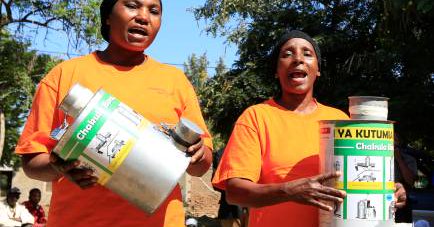Tanzanians come up with unique, eco-friendly way to store harvests

- Country:
- Tanzania
Improved storage techniques have shown they can cut the loss of harvested maize by 10 percent in Tanzania, and help one-third fewer households go hungry in the lean season, Swiss researchers said.
As Africa's population rises and climate change threatens more harvests, simple efforts to protect what is harvested could play a key role in staving off hunger on the continent, they said.
"Improved on-farm storage is particularly important in the 'lean season'" - the period when one harvest is used up and the next is not yet available said study coordinator Matthias Huss.
That "is often a time of increased food insecurity and hunger," he said.
The study, which was conducted by the University of Zurich, assessed how better crop storage would affect household food security and market prices, said researcher Michael Brander.
One year into the study, "the most astonishing finding so far is that the number of people that go hungry has reduced by one-third", Brander said.
The study assessed 1,000 small-scale farmers who were part of a larger project begun in 2013 by Swiss development group Helvetas. That project trained 50,000 farmers in better crop storage techniques using metal bins and hermetically sealed bags.
Selemani Nyange, a 60-year-old farmer, said that prior to the study she would lose three out of the seven bags of her annual maize crop to pests.
These days her losses are near zero, said the farmer from Mnenia in central Tanzania.
The bags, also being used in a crop-storage project in Malawi, have two linings of high-density polyethylene and an outer layer of woven polypropylene. These layers keep out most oxygen, preventing insects from surviving and reproducing.
Up to 98 percent of insects can be eliminated from stored grain within a month of putting it in the bag, cutting losses, according to a 2017 study published in the journal Plos One.
In Tanzania, bags cost about $2.20 each and metal bins about $100 for 500-kg of storage, researchers said. The improved storage allows farmers to store surpluses longer, and wait for market prices to rise before selling.
BIG LOSSES
The Swiss research, which is scheduled to run until 2020, is one of a number of efforts by government agencies and aid groups, among others, to assess post-harvest crop losses and boost rural household incomes.
The U.N.'s Food and Agriculture Organization (FAO) says such losses in sub-Saharan Africa alone total $4 billion a year - enough to feed at least 48 million people.
About 20 percent of cereal harvests, 40 to 50 percent of tubers, fruits, and vegetables, 27 percent of oilseeds, meat and milk, and 33 percent of fish, are lost, the FAO said.
Scientists also warned in August that rising temperatures due to climate change will see larger numbers of hungrier insects attacking crops - leaving less to be harvested.
They said a 2-degree Celsius (3.6-degree Fahrenheit) temperature rise would see insects consume 213 million tons of maize, wheat, and rice by 2050 - up from 166 million tons today.
And as the invasive fall armyworm pest continues to wreak havoc on crops across Africa - and has now been spotted in India - keeping safe what is harvested will become even more important, experts say.
Brander said the biggest losses of harvested crops in Kondoa, prior to the introduction of bags and metal bins, came during storage, with a quarter of the area's maize crop typically lost. Pests and mold were the key worries.
Losses of grains such as cereals and pulses - staples for most of the rural population - was even higher at 30 percent, he said. The losses often meant less food and fewer seeds available for the following year's planting.
Rakesh Munankami, a project team leader at Helvetas, said his organization has worked with 50,000 farmers across Tanzania on crop storage.
"Eighty-two percent have adopted the new storage technologies - around 2,700 metal silos and 50,000 hermetic bags have been distributed," he said.
He said the bags and metal bins typically extend food supplies by two months and increase household incomes by about $90.
EVICTING THE WEEVILS
Philemon Eliabu Ndosi, a senior programme officer at the Ministry of Agriculture, said more and more farmers know about the new storage technology.
"Currently we have 16 locations which consist of 68 villages where the new technology is widely used," he told a group of Kondoa farmers in July, adding that the cost savings from these storage options made them popular.
The bags and bins reduce the need to mix harvested food with pest-killing chemicals and the cost of paying workers to do that mixing, he said.
Amina Hussein, one of the farmers involved in the study, said storage used to be her biggest problem. Every year, much of the maize harvested from her five-acre farm would go to waste, she said.
"In a good harvest I got 20-30 bags of maize, but due to storage problems I would lose almost half of it to weevils," she said.
That amounted to 86,000 Tanzanian shillings ($37), which "is a big loss for my family," she said.
The new bags are more robust, as well as more effective, than the plastic bags she used earlier, Hussein said.
"(The old) bags would tear very easily and I used to buy (them) almost three times a year. But now, with the hermetic bags, the grains are able to stay fresh for a long period of time," Hussein said.
(This story has not been edited by Devdiscourse staff and is auto-generated from a syndicated feed.)










